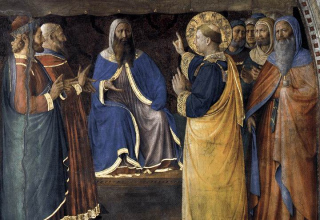The Great Sanhedrin (which in Greek means 'a sitting together' or 'council') was the supreme council of the Jews who met within Jerusalem's temple in a place known as the chamber of hewn stones (although they sometimes met in the house of the High Priest). The Sanhedrin was like the U.S. Supreme court in that they were the final authority on decisions that affected the religious and political life of all Jews.
The council convened each day of the week except the Sabbath and the annual Biblical Holy Days. In New Testament times, the Sanhedrin was composed of seventy-one members (the High Priest, a vice chief justice and sixty-nine general members). The Pharisees (e.g. Nicodemus, John 3:1 - 10) as well as the Sadducees, scribes, elders and possibly others, were represented on the council.
Members the Great Sanhedrin were required to possess scholarship, modesty, strength, courage, and popularity among their fellow men. Their rulings were binding (for a time) on all Jews scattered throughout the world. Their jurisdiction, however, was greatly curtailed by Herod the Great and then by the Roman Empire.
The council is traditionally viewed as the last institution that commanded universal Jewish authority among the Jewish people. Until the time when Judea was subjected to the Romans, it had the power of life and death. In New Testament times, however, although it retained the power of passing sentence, the Roman Empire retained the right to accept or reject their verdicts and to ultimately decide to carry out penalties.

In the New Testament, the Sanhedrin are variously referred to as "the chief priests, the elders, and all the council" (Matthew 26:59, NKJV throughout) and the "chief priests, the scribes, and the elders of the people" (Matthew 26:3).
They are also called the "chief priests and elders of the people" (Matthew 27:1) and in several places referred to as "the council" (Mark 15:1, Matthew 5:22, Acts 5:21, etc.).
Wanting Christ Dead
This group was the driving force that insured Jesus was betrayed, falsely arrested, falsely accused, unjustly judged, and condemned to a death on the cross. It was members of the council who bribed Judas Iscariot with thirty pieces of silver to betray Jesus (Matthew 26:14 - 16). It was they who, contrary to Jewish law, had Jesus arrested without a formal accusation of wrongdoing (Deuteronomy 19:15).
During Jesus' first trial the charge of blasphemy against God was used by the Sanhedrin council to justify giving him a death sentence (Mark 14:61 - 64, Matthew 26:62 - 66). Yet, when Jesus was brought to the Romans for punishment, they changed the charge against him to treason (Luke 23:1 - 3, John 19:12)!
It was members of the council who, when Pontius Pilate asked a crowd whether Jesus or Barabbas should be set free, got them to select Barabbas (Matthew 27:15 - 23).
Members of the council not only went to see Jesus suffer on the cross, they also taunted and ridiculed him (Luke 23:35 - 37). Members of the Sanhedrin, after they were told of the resurrection of Jesus, also paid a large bribe to Roman soldiers to have them LIE and state that Jesus' disciples came and secretly stole his body in the middle of the night (Matthew 28:11 - 15).